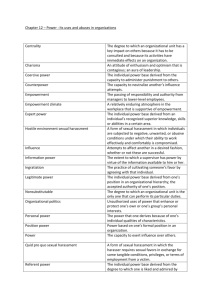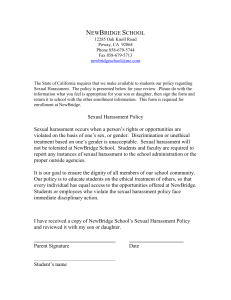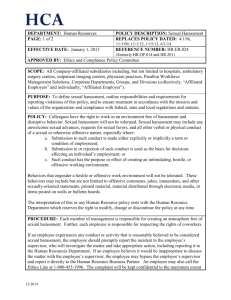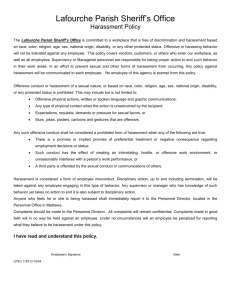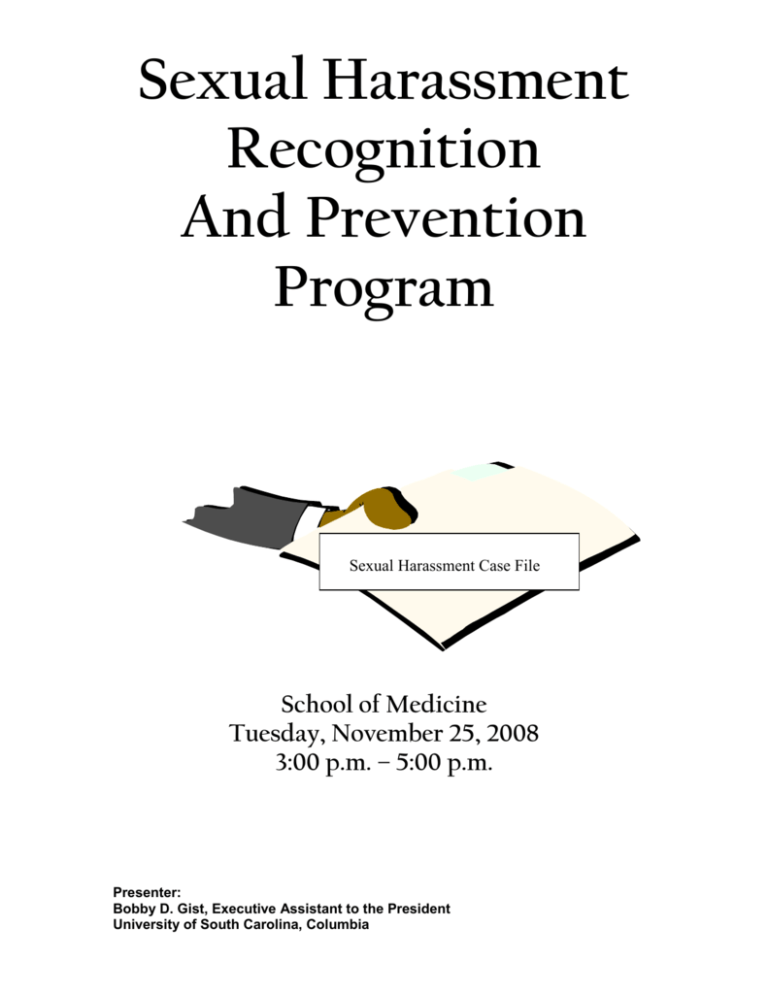
Sexual Harassment
Recognition
And Prevention
Program
Sexual Harassment Case File
School of Medicine
Tuesday, November 25, 2008
3:00 p.m. – 5:00 p.m.
Presenter:
Bobby D. Gist, Executive Assistant to the President
University of South Carolina, Columbia
Sexual Harassment
A Real Issue in the Workplace and Academic Arena
INTRODUCTION
Sexual Harassment on campus is a serious issue that educational institutions must address
and seek to eliminate. The U.S. Equal Employment Opportunity Commission (EEOC),
this nation’s chief anti-discrimination enforcement agency, has obtained approximately
$441 million in monetary benefits for persons who have filed formal complaints of sexual
harassment over the past nine years (1999-2007). This $441 million dollars in monetary
benefits does not include the millions of dollars that has been awarded to plaintiffs who
have filed sexual harassment lawsuits in state and federal courts throughout the nation.
In addition, the legal cost of bringing and defending sexual harassment actions in the
courts has escalated and reached epidemic proportions.
In fact, College and University campuses are not exempt and have also been hit hard in
the pocketbook as it relates to issues of sexual harassment. College presidents and other
high ranking officials, both tenured faculty and non-tenured administrators have lost their
jobs and their careers in higher education because of sexual harassment allegations.
With the passage of the 1991 Civil Rights Act victims of alleged sexual harassment are
now in the position of recouping not only actual damages, but also punitive and
compensatory damages up to $300,000.00, as well as attorney fees. Additionally, under
the 1991 Civil Rights Act, victims can now obtain jury trials where judgements against
employers are far more likely. In 1990 prior to the passage of the 1991 Civil Rights Act,
the EEOC received 6,127 formal complaints of sexual harassment and they obtained $7.7
million dollars in monetary settlements. However, in 2001, ten years after the passage of
the 1991 Civil Rights Act, the EEOC received over 15,000 complaints (15,475) of sexual
harassment and recouped approximately seven times the monetary benefits (53.0 million)
that were recouped in 1990. Over the past three years alone, the monetary benefits
recouped for victims of sexual harassment totaled $146 million in this country and this
does not include the millions of dollars awarded by State and Federal courts after lawsuits
were filed.
Sexual harassment if allowed to occur today and not addressed in your organization or
institution is a costly proposition. Today, more than ever, employees and students are
willing to come forward and demand that they not be subjected to illegal discrimination
in the workplace or in the academic arena.
In 2005 alone, 12,679 complaints were filed by both men and women with the EEOC. In
fact, last year approximately 16% of the sexual harassment complaints filed were filed by
men (2007-16.0%).
Remember you are the front line of defense when it comes to protecting your institution
with regard to “Preventing Sexual Harassment on Campus,” whether you are a faculty or
staff member.
2
SEXUAL HARASSMENT IS AGAINST THE LAW
Sexual harassment in the workplace is a violation of Title VII of the Civil Rights Act of
1964 and the South Carolina Human Affairs Law.
Sexual harassment within the educational environment is a violation of federal law, state
law and University Policy.
WHAT IS SEXUAL HARASSMENT?
Employment Perspective:
Sexual harassment is a form of employment misconduct which undermines the integrity
of the employment relationship. All employees must be allowed to work in an
environment free from unsolicited and unwelcome sexual overtures. Sexual harassment
is defined as any unwelcome, one-sided, sexual advancement; requests for sexual favors;
and other, verbal or physical conduct of a sexual nature that comes from supervisors,
bosses, co-workers, clients or other individuals in the workplace.
Educational Perspective:
Sexual harassment is a form of misconduct which undermines the integrity of the
educational and academic arena on the basis of sex.
In the academic arena, sexual harassment unreasonably interferes with one’s ability to
perform, free of harassment, predicated upon their sex. Sexual harassment is defined as
any unwelcome, one-sided, sexual advancement; requests for sexual favors; and other
verbal or physical conduct of a sexual nature that comes from faculty, staff, students, or
other individuals in the educational arena.
3
Definition of Sexual Harassment
Sexual harassment is unwanted sexual or gender based behavior
that occurs when one person has formal or informal power over the
other.
There are three elements to sexual harassment:
A. The behavior is unwanted or unwelcome.
B. The behavior is sexual or related to the gender of the person.
C. The behavior occurs in the context of a relationship where one
person has more formal power than the others (such as a
supervisor over an employee or a faculty member over a
student) or more informal power (such as one peer over
another).
4
Sexual Harassment Charges
EEOC & FEPA’s Combined: FY 1999--FY 2007
The following chart represents the total number of charge receipts filed and resolved
under
Title VII alleging Sexual Harassment discrimination as an issue.
The data in the Sexual Harassment table reflect charges filed with EEOC and the state
and local Fair Employment Practices agencies around the country that have a work
sharing agreement with the Commission.
The data in this report is complied by the Office of Research, Information, and Planning
and taken from EEOC’s Charge Data System-National data base.
Sexual
Harassment
Charges
Receipts
FY
1999
FY
2000
FY
2001
FY
2002
FY
2003
15,222
15,836
15,475
14,396
13,566 13,136
% of Charges
Filed by Males
Resolutions
12.1%
13.6%
13.7%
14.9%
14.7%
15.1%
14.3%
15.4%
16.0%
16,524
16,726
16,383
15,792
14,534
13,786
12,859
11,936
11,592
Settlements
1,361
8.2%
1,676
10%
1,568
9.6%
1,692
10.7%
1,783
12.3%
1646
11.9%
1,471
11.4%
1,458
12.2%
1,571
13.6%
Withdrawals
with Benefits
Administrative
Closures
1,299
7.9%
5,401
32.7%
1,389
8.3%
4,628
27.7%
1,454
8.9%
4,293
26.2%
1,235
7.8%
3,957
25.1%
1,300
8.9%
3,600
24.8%
1,138
8.3%
3,256
23.6%
1,146
8.9%
2,808
21.8%
1,175
9.8%
2,838
23.8%
1,177
10.2%
2,804
24.2%
No Reasonable
Cause
Reasonable
Cause
Successful
Conciliations
7,272
44.0%
1,180
7.1%
383
2.3%
7,370
44.1%
1,659
9.9%
524
3.1%
7,309
44.6%
1,746
10.7%
551
3.4%
7,445
47.1%
1,463
9.3%
455
2.9%
6,703
46.1%
1,148
7.9%
350
2.4%
6,708
48.7%
1,037
7.5%
311
2.3%
6,364
49.5%
1,070
8.3%
324
2.5%
5,668
47.5%
797
6.7%
253
2.1%
5,273
45.5%
767
6.6%
282
2.4%
Unsuccessful
Conciliations
Merit
Resolutions
Monetary
Benefits
(Millions)*
797
4.8%
3,840
23.2%
1,135
6.8%
4,724
28.2%
1,195
7.3%
4,768
29.1%
1,008
6.4%
4,390
27.8%
798
5.5%
4,231
29.1%
726
5.3%
3,821
27.7%
746
5.8%
3,687
28.7%
544
4.6%
3,430
28.7%
485
4.2%
3,515
30.3%
$50.3
$54.6
$53.0
$50.3
$50.0
$37.1
$47.9
$48.8
$49.9
5
FY
2004
FY
2005
FY
2006
FY
2007
12,679
12,025
12,510
TYPES OF SEXUAL HARASSMENT
Two Legal Claims of Harassment Recognized by the Federal Courts
Federal law recognizes essentially two types of sexual harassment:
1. "quid pro quo" and
2. "hostile and offensive work environment."
Quid pro quo harassment, according to the EEOC Policy Guidelines on Current
Issues of Sexual Harassment, occurs when the harasser conditions the granting of
a job benefit or the avoidance of a job detriment upon receipt of some sexual favor
from another employee. Quid pro quo harassment is the most blatant, most
recognizable, and most obvious form of sex harassment. Normally, the victimized
employee is forced to choose between the unwanted sexual demands and the loss
of tangible job benefits or the imposition of a detriment at work (e.g., a promised
promotion, sleep with me or be fired, avoidance of a demotion, a year-end bonus,
or a decent raise).
Hostile and offensive work environment, according to the EEOC, looks at the
offensive workplace behaviors that create an abusive employment setting. While
the offensive conduct could be essentially the same as in quid pro quo harassment,
hostile work environment focuses upon the impact of the conduct on another
employee's work environment. When the unwanted verbal or physical harassment
"unreasonably" interferes with the employee's work performance or when it
creates an intimidating, offensive work setting, hostile work environment
harassment has occurred. To unreasonably interfere with someone's work
environment, the harassment must be so severe and pervasive that a "reasonable
person" would not put up with it.
6
Types of Sexual Harassment Recognized by the Federal Courts
1. Quid Pro Quo (what equals quid pro quo)
2. Hostile Work Environment (what equals hostile environment)
Sexual harassment exists when any of four conditions are met:
1.
Submission to the sexual conduct or behavior is made a term or condition,
either explicitly or implicitly, of employment;
2.
Submission or rejection of the sexual conduct or behavior is used as a
factor in decisions affecting that person's employment;
3.
The sexual conduct or behavior has either the purpose or effect of
"substantially interfering" with a person's employment; or
4.
The sexual conduct or behavior creates an "intimidating, hostile or
offensive work environment.
Conditions #1 and #2 = quid pro quo harassment
Conditions #3 and #4 = hostile work environment harassment
7
QUID PRO QUO
HOSTILE ENVIRONMENT
When something-a grade, a job, or a
letter of recommendation is given or
withheld on the basis of an
individual’s response to a request for
sexual favors; i.e., “If you don’t sleep
with me, you’ll fail my class.”
An atmosphere that interferes with a
student’s ability to learn or participate in the
school setting or an employee’s ability to
work.
One instance is enough to prove
sexual harassment.
The behavior is unwelcome, based on sex or
gender, and is severe or pervasive enough to
create a hostile or abusive environment that
alters a term, condition or privilege of
employment or education.
An institution is liable for workplace
harassment if a supervisor, teacher or
professor with authority to hire or fire an
employee subjects that employee to a
significant change in employment status
due to acceptance or rejection of sexual
advances.
For peer harassment, a school may be held
liable if it knew or should have known of the
harassment and failed to take prompt and
effective remedial action.
An institution is liable for employeestudent harassment only if an official with
authority to address the alleged
discrimination knew of it, failed
to respond to it and acted with deliberate
indifference.
The less severe the conduct, the more it has
to be repeated to qualify as sexual
harassment.
If the harassment is directed against a school
employee by a supervisor with immediate or
successfully higher authority over the
employee, the school will be vicariously
liable for the harassment but can defend
itself by showing that: 1) officials exercised
reasonable care to prevent and promptly
correct any sexually harassing behavior- in
other words, had a strong and wellpublicized harassment policy and complaint
procedure ; and 2) the employee didn’t
complain or seek help through procedures
made available by the school.
An institution is liable for employee-student
harassment only if an official with authority
to address the alleged discrimination knew
of it, failed to respond to it and acted with
deliberate indifference.
8
Sexual Harassment may be verbal, non-verbal, physical,
non-physical and visual.
Verbal
Verbal statements that might be illegal harassment can include, but are not limited
to, the following comments:
1.
2.
3.
4.
5.
6.
7.
8.
9.
10.
Sexual propositions
Asking questions about an employee's sex life or conduct
Calling women/ men by crude sexual names
Asking personal or intimate questions
Making sexual threats
Bragging about sexual prowess
Making negative sexual comments about women/ men based upon gender
Repetitive asking for dates, affection, attention, or touching
Making fun of a co-worker in a sexual way
Verbally abusing a member of the opposite sex
Physical
Offensive, illegal physical conduct can include, but is not limited to, the following
behavior:
1.
2.
3.
4.
5.
6.
7.
8.
9.
10.
Touching
Jostling
Bumping or blocking
Leering or staring
Taking unwelcome photographs
Physically restraining a person of the opposite sex
Indecent exposure
Passing or posting sexually offensive materials
Groaning, sighing, or offering sexual thoughts
Whistling, jeering, hooting
Finally, the workplace can also be found to be sexually offensive and hostile
where there are sexual photographs and/ or drawings, sexual graffiti, and other
types of sexually hostile physical behavior or conduct at work.
9
Common situations that may involve sexual harassment include:
Pinups in the workplace. Pinups containing sexual material (such as
centerfolds) can create a hostile work environment. Don’t allow these in the
workplace.
Asking a coworker for a date. This by itself is not harassment. But if the
person refuses the offer, continued asking can become harassment and should
be stopped if a complaint is made.
Rude treatment of women. A supervisor who treats women rudely, or who
constantly demeans the ability of women to perform work, can be guilty of
sexual harassment since adverse actions are being taken on account of the
employees’ gender.
Verbal abuse and jokes. Comments about a person’s appearance or jokes of a
sexual nature can constitute harassment if they occur often and are unwelcome.
You should make it a policy to stop all types of sexually oriented comments in
the workplace.
Intentional touching. A single act of intentional and unwelcome touching of
a sexual nature will usually be found to be sexual harassment.
Are gender harassment and sexual harassment the same?
There are forms of harassment that are gender-based but are non-sexual in nature.
Gender-based harassment is harassment that would not have occurred but for the sex of
the victim. It lacks sexually explicit content but is directed at one sex and motivated by
animus against that sex, whether female or male.
Example: A comment like “You’re a woman, what do you know?” may amount
to gender-based harassment even though it does not carry a sexual connotation.
10
Consensual Relationships and Claims
Consensual relationships can result in claims if:
The romance goes sour.
One party did not entirely welcome the
relationship or, after a time, finds it
distasteful and perceives continued
pursuit as harassment;
A third party claims favoritism.
A third party perceives favoritism in
the relationship and believes he or she
should have been entitled to the same
benefits as a party in the relationship,
such as a better job, salary increase,
larger office, more favorable
recommendation, better lab facilities,
etc.; or
A third party finds the behavior
disruptive or offensive.
A third party complains that the
behavior between the parties – such as
making love indiscreetly in the office –
is disruptive and offensive.
11
Is the Institution Liable for Harassment?
Federal and many state laws make employers,
including educational institutions, liable for sexual
harassment. Liability depends on who is doing and
receiving the harassment.
Harassment of a school employee by a co-worker.
Harassment of a student by a fellow student.
Institutions are responsible when co-workers harass
each other and, in some cases, when students harass
each other, if school officials knew or should have
known of the harassment and did nothing to stop it. If
harassment is reported to a manager or the manager
learns about it, or if it was so obvious that the manager
should have known about it, the institution may be
liable if it does nothing.
Harassment of a school employee by a supervisor.
Employers are responsible if the harassing supervisor
takes a tangible employment action against the
harassed employee. Employers are responsible if there
is no tangible employment action, such as a demotion,
unless: 1) they exercised reasonable care to prevent
and promptly correct the harassment; and 2) the
employee didn’t complain or seek help through
procedures set up by the employer.
Harassment of a student by a teacher or school
employee. An institution is not liable unless an
official with authority to address the alleged
discrimination and correct it knew of the situation and
failed to respond to it, and showed deliberate
indifference.
12
The 12 Most Frequently asked questions about
Sexual Harassment from employees:
1. Can compliments be a form of sexual harassment?
2. Can I be accused of sexual harassment if no one objects to me and states
that my behavior is not welcome?
3. How can I protect myself from a false charge of sexual harassment?
4. What should I do if I am harassed?
5. Is it considered to be sexual harassment if I tell a sexually explicit joke?
6. Can how a woman dresses cause sexual harassment?
7. Do I need to change my behavior just because someone may be offended in
the workplace?
8. Why can’t the person who is being harassed just tell the harasser to stop?
9. What about my freedom of speech in the workplace?
10. What are my obligations as a supervisor to prevent sexual harassment?
11. What if you are a touchy-feely kind of person?
12. Is sexual harassment really a serious issue?
13
Civil Law Suits (Common Law Torts) Arising From Sexual Harassment
Claims
In addition to filing under the various state or federal laws, individuals who feel they
have been sexually harassed can file civil lawsuits alleging common law torts, or civil
wrongs. Some examples are listed below:
Charges of assault and battery, such as when someone experiences menacing gestures
or unwanted touching, such as being kissed, embraced or rubbed against;
Intentional infliction of emotional distress, such as when someone has been
continually harassed (especially if the behavior is severe, pervasive or outrageous), or
when the victim informed an agent of the employer and the response was inadequate;
Defamation, such as when rumors about a person’s sexual life are circulated;
Interfering with an employment contract, such as when a person makes it impossible
for the complainant to obtain or keep employment (this might occur when a rebuffed
supervisor persuades an employer to fire the employee who rebuffed his or her
advances);
Negligent supervision, such as when a supervisor has not acted properly;
Negligent hiring; not properly checking the references and background of a person
who was hired and is now the accused or harasser.
Negligent retention; Retaining a person with a record of misconduct.
Invasion of privacy, especially intrusion, such as when a harasser continually calls a
worker at home and asks about his/her sex life, or when a victim is followed into a
restroom;
Wrongful discharge, such as when someone has been fired for refusal to tolerate
sexual harassment;
False imprisonment, such as when a victim is harassed in a setting and is not allowed
to leave; and
Loss of consortium, such as when a woman or man is so upset by sexual harassment
that she or he cannot have sexual relations with their husband or wife.
Note:
Title VII and Title IX claims may be filed simultaneously with a tort claim. Tort
claims often have a longer time limit for filing: usually one to three years, depending
on the tort and particular state law.
Damages are not limited in tort actions; therefore, tort actions often are pursued by
employees to collect damages not allowed under Title VII.
In tort cases, the individual harasser can be named as a defendant. In contrast, Title
VII and Title IX cases, the employer alleged to have allowed discrimination is
generally the sole defendant.
Although damages are recoverable under Title VII and Title IX, victims can continue
to file tort claims in addition to other charges.
14
Employees may be more likely to file tort claims because of the limitations placed on
monetary damages under the Civil Rights Act of 1991.
Unlike Title VII or Title IX, which do not require an attorney to file charges, most
persons filing tort claims will need to have an attorney unless they represent
themselves.
Tort laws can also be used by persons such as visitors, contractors and vendors who
are not protected by Title VII or Title IX because they are neither students nor
employees, but were harassed by students or employees.
15
POSSIBLE STEPS THAT MANAGEMENT
CAN TAKE TO PREVENT SEXUAL
HARASSMENT IN THE WORKPLACE
1. Document all actions and incidents of alleged sexual misconduct and
harassment.
2. Adopt a strong policy statement prohibiting sexual harassment and
disseminate the statement to all employees.
3. Train all managers and supervisors on the prevention of sexual harassment.
4. Set up an internal mechanism for employee complaints and instruct
employees how to use the internal process.
5. Always take complaints seriously and investigate promptly and carefully and
consult the Human Resource or EEO Office immediately.
6. Develop and enforce a zero tolerance policy as it relates to sexual harassment
in the work environment.
7. Document.
8. Be fair.
9. Set a GOOD EXAMPLE!!
16
Please refer to the EOP web site,
http://www.sc.edu/eop/ for information regarding the
University’s Sexual Harassment Policy. [ EOP 1.02 Sexual
Harassment]
17






